Related Research Articles

Tibetan Buddhism is a form of Buddhism practiced in Tibet, Bhutan and Mongolia. It also has a sizable number of adherents in the areas surrounding the Himalayas, including the Indian regions of Ladakh, Darjeeling, Sikkim, and Zangnan, as well as in Nepal. Smaller groups of practitioners can be found in Central Asia, some regions of China such as Northeast China, Xinjiang, Inner Mongolia and some regions of Russia, such as Tuva, Buryatia, and Kalmykia.

Asaṅga was one of the most important spiritual figures of Mahayana Buddhism and the founder of the Yogachara school. Traditionally, he and his half-brother Vasubandhu are regarded as the major classical Indian Sanskrit exponents of Mahayana Abhidharma, Vijñanavada thought and Mahayana teachings on the bodhisattva path. He is also traditionally considered as one of the seventeen Nalanda masters who taught at the monastery which is located in modern-day Bihar.

The Gelug is the newest of the four major schools of Tibetan Buddhism. It was founded by Je Tsongkhapa (1357–1419), a Tibetan philosopher, tantric yogi and lama and further expanded and developed by his disciples.

Maitreya (Sanskrit) or Metteyya (Pali), is a bodhisattva who is regarded as the future Buddha of this world in all schools of Buddhism, prophesied to become Maitreya Buddha or Metteyya Buddha. In some Buddhist literature, such as the Amitabha Sutra and the Lotus Sutra, he is also referred to as Ajitā. In Tibetan Buddhism he is known as the "Lord of Love" or the "Noble Loving One". The root of his name is the Sanskrit word maitrī. The name Maitreya is also related to the Indo-Iranian name Mitra.
A tulku is a distinctive and significant aspect of Tibetan Buddhism, embodying the concept of enlightened beings taking corporeal forms to continue the lineage of specific teachings. The term "tulku" has its origins in the Tibetan word "sprul sku", which originally referred to an emperor or ruler taking human form on Earth, signifying a divine incarnation. Over time, this term evolved within Tibetan Buddhism to denote the corporeal existence of highly accomplished Buddhist masters whose purpose is to ensure the preservation and transmission of a particular lineage.
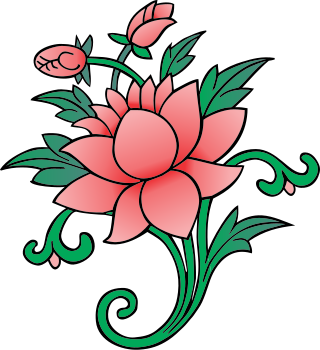
In Mahayana Buddhism, bodhicitta is the mind (citta) that is aimed at awakening (bodhi) through wisdom and compassion for the benefit of all sentient beings.
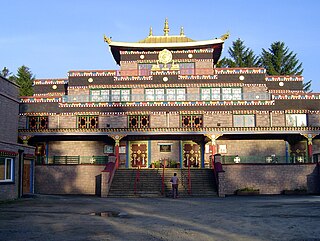
Kagyu Samye Ling Monastery and Tibetan Centre is a Tibetan Buddhist complex associated with the Karma Kagyu school located at Eskdalemuir, Scotland.

The New Kadampa Tradition – International Kadampa Buddhist Union (NKT—IKBU) is a global Buddhist new religious movement founded by Kelsang Gyatso in England in 1991. In 2003 the words "International Kadampa Buddhist Union" (IKBU) were added to the original name "New Kadampa Tradition". The NKT-IKBU is an international organisation registered in England as a charitable, or non-profit, company. It currently lists more than 200 centres and around 900 branch classes/study groups in 40 countries. founded by the Tibetan-born Geshe Kelsang Gyatso, the BBC describes the New Kadampa Tradition as "one of the major Buddhist schools in the UK".

Thubten Yeshe (1935–1984) was a Tibetan lama who, while exiled in Nepal, co-founded Kopan Monastery (1969) and the Foundation for the Preservation of the Mahayana Tradition (1975). He followed the Gelug tradition, and was considered unconventional in his teaching style.
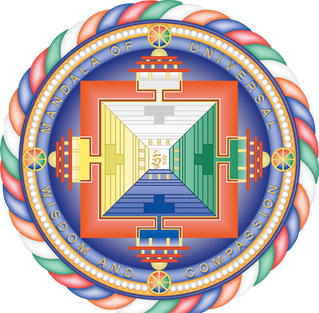
The Foundation for the Preservation of the Mahayana Tradition (FPMT) was founded in 1975 by Gelugpa Lamas Thubten Yeshe and Thubten Zopa Rinpoche, who began teaching Tibetan Buddhism to Western students in Nepal. The FPMT has grown to encompass over 138 dharma centers, projects, and services in 34 countries. Lama Yeshe led the organization until his death in 1984, followed by Lama Zopa until his death in 2023. The FPMT is now without a spiritual director; meetings on the organization's structure and future are planned.

Sogyal Rinpoche was a Tibetan Dzogchen lama. He was recognized as the incarnation of a Tibetan master and visionary saint of the 19th century, Tertön Sogyal Lerab Lingpa. Sogyal Rinpoche was the founder and former spiritual director of Rigpa — an international network of over 100 Buddhist centres and groups in 23 countries around the world — and the author of the best-selling book The Tibetan Book of Living and Dying, which has been printed in 30 languages and 56 countries. Before his retirement, in the wake of abuse allegations in 2017, he had been teaching for 40 years in Europe, America, Asia and Australia.
Geshe or geshema is a Tibetan Buddhist academic degree for monks and nuns. The degree is emphasized primarily by the Gelug lineage, but is also awarded in the Sakya and Bön traditions. The equivalent geshema degree is awarded to women.
Phowa is a tantric practice found in both Hinduism and Buddhism. It may be described as "transference of consciousness at the time of death", "mindstream transference", "the practice of conscious dying", or "enlightenment without meditation". In Tibetan Buddhism phowa is one of the Six yogas of Naropa and also appears in many other lineages and systems of teaching.
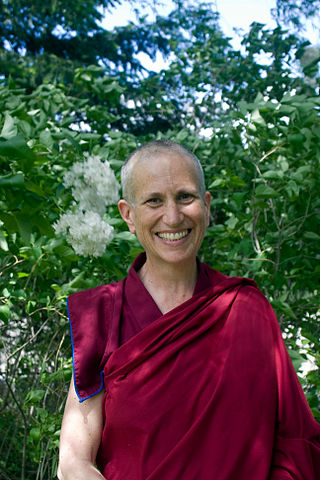
Thubten Chodron, born Cheryl Greene, is an American Tibetan Buddhist nun, author, teacher, and the founder and abbess of Sravasti Abbey, the only Tibetan Buddhist training monastery for Western nuns and monks in the United States. Chodron is a central figure in the reinstatement of the Bhikshuni ordination of women. She is a student of the 14th Dalai Lama, Tsenzhab Serkong Rinpoche, Lama Thubten Yeshe, Thubten Zopa Rinpoche, and other Tibetan masters. She has published many books on Buddhist philosophy and meditation, and is co-authoring with the Dalai Lama a multi-volume series of teachings on the Buddhist path, The Library of Wisdom and Compassion.

Women in Buddhism is a topic that can be approached from varied perspectives including those of theology, history, anthropology, and feminism. Topical interests include the theological status of women, the treatment of women in Buddhist societies at home and in public, the history of women in Buddhism, and a comparison of the experiences of women across different forms of Buddhism. As in other religions, the experiences of Buddhist women have varied considerably.

Amitabha Buddhist Centre is a Buddhist institution in Geylang, Singapore. It is affiliated with the Foundation for the Preservation of the Mahayana Tradition (FPMT), an international non-profit organisation, founded by Lama Thubten Yeshe.
Geshe Acharya Thubten Loden was the spiritual leader of the Tibetan Buddhist Society in Australia. Geshe Loden established the Peaceful Land of Joy Meditation Centre in Yuroke, Victoria, and has written many books. In 2011, he was named Hume Citizen of the Year.
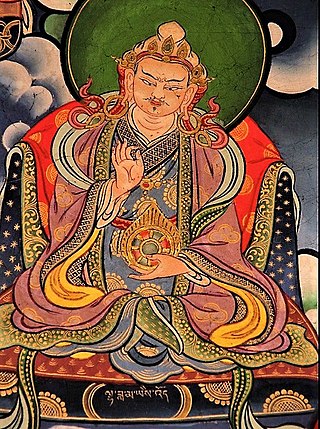
Yeshe-Ö was the first notable lama-king in Tibet. Born as Khor-re, he is better known as Lhachen Yeshe-Ö, his spiritual name.
Nirmāṇakāya is the third aspect of the trikāya and the physical manifestation of a Buddha in time and space. In Vajrayāna it is described as "the dimension of ceaseless manifestation."
References
- ↑ December 2000; Willis was named as one of six "Spiritual innovators for the new millennium"
- ↑ Labi, Nadya (2000). "Innovators - Time 100: The Next Wave - Spiritual Leaders - Jan Willis: Of Color and the Cushion". Time Magazine . Archived from the original on July 12, 2011. Retrieved 2013-08-18.
- ↑ "Spirituality in America," 2005.
- ↑ Tibetan Buddhism: Learning To Let Go - Newsweek and The Daily Beast
- ↑ Tibetan Buddhism: Learning to Let Go; After college, this child of Jim Crow went to Nepal, where she found the divine within and made peace with her past. (Jan Willis)(Cover Story ...)
- ↑ May 2007 issue cites her as one of the 150 most influential African Americans (one of sixteen religious leaders so named).
- ↑ "Biography - Aetna African American Calendar 2011". Archived from the original on 2016-03-03. Retrieved 2011-02-19.
- ↑ "Profile - Aetna African American Calendar 2011". Archived from the original on 2011-07-07. Retrieved 2011-03-01.
- ↑ Aetna's 2011 African American History Calendar Highlights Leaders of Faith-Based Health Initiatives | Business Wire
- ↑ AETNA NEW : Aetna's 2011 African American History Calendar Highlights Leaders of Faith-Based Health Initiatives | 4-Traders
- ↑ "Faculty Emeriti, College of East Asian Studies - Wesleyan University". www.wesleyan.edu. Retrieved 2024-10-08.
- ↑ "Jan Willis: Professor of Religion: Books". Wesleyan University . Archived from the original on July 5, 2013. Retrieved 2013-08-18.